

Because Play Matters - Blog. Teaching for Student Learning - Richard I. Arends, Ann Kilcher. Teaching for Student Learning: Becoming an Accomplished Teacher shows teachers how to move from novice to expert status by integrating both research and the wisdom of practice into their teaching.
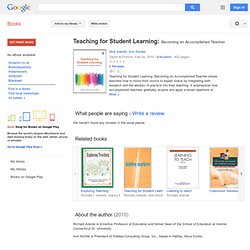
Key Strategies Brief. Five “Key Strategies” for Effective Formative Assessment In order to build a comprehensive framework for formative assessment, Wiliam and Thompson (2007) proposed that three processes were central: 1.
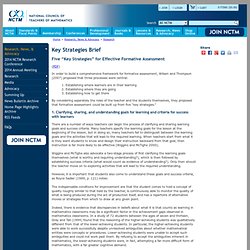
Establishing where learners are in their learning2. Establishing where they are going3. Establishing how to get there By considering separately the roles of the teacher and the students themselves, they proposed that formative assessment could be built up from five “key strategies.” 1. There are a number of ways teachers can begin the process of clarifying and sharing learning goals and success criteria. Wiggins and McTighe also advocate a two-stage process of first clarifying the learning goals themselves (what is worthy and requiring understanding?) However, it is important that students also come to understand these goals and success criteria, as Royce Sadler (1989, p. 121) notes: A simple example may be illustrative here. 2.
Figure 1: Diagnostic item on elementary fractions 3. 4. 5. ———. Two Stars and a Wish. What do you do when your child shows you a piece of writing that he has authored?
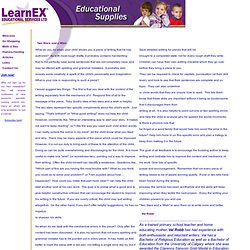
As with most rough drafts, it probably contains handwriting that is not perfectly neat, some sentences that are not completely clear, and may be littered with spelling and grammar mistakes. It probably also reveals some creativity, a spark of the child's personality and imagination. What is your role in responding to such a piece? I would suggest two things. To sharpen his skills. So when do we deal with the mechanical errors in the piece? Save detailed editing for pieces that will be brought to a completed state, not for every rough draft they write. They can be required to check for capitals, punctuation (at their skill level), and look to see that their sentences are complete and on topic. Or circle words that they are unsure how to spell. Writing at all. He forgot or a word family that would help him avoid the error in the future?
Praise and encouragement. Val Robb. Peer Review. Grades 9 – 12 | Lesson Plan | Standard Lesson And in Conclusion: Inquiring into Strategies for Writing Effective Conclusions While drafting a literary analysis essay (or another type of argument) of their own, students work in pairs to investigate advice for writing conclusions and to analyze conclusions of sample essays.
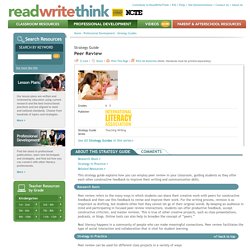
They then draft two conclusions for their essay, select one, and reflect on what they have learned through the process. Grades 9 – 12 | Lesson Plan | Unit Reading Shakespeare's The Tempest through a Postcolonial Lens Students take a postcolonial perspective on the portrayal of Caliban from Shakespeare's The Tempest by comparing it to a modern adaptation of the play.
Analyzing the Rhetoric of Corporate Logos across Time Students think critically about how design elements in logos work together to tell a changing story about a company or product in this visual rhetoric lesson. Sample Forms - Peer Review. Students utilizing well-developed feedback forms for peer review can in effect give students a deeper understanding of how their writing affects different readers, reinforce familiarity with revising strategies, and assist students in developing a familiarity with scientific writing expectations.
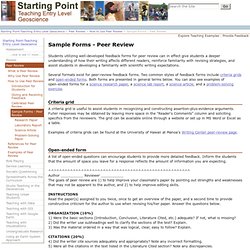
Several formats exist for peer-review feedback forms. Two common styles of feedback forms include criteria grids and open-ended forms. Both forms are presented in general terms below. Peer Review: Narrative. ReadWriteThink couldn't publish all of this great content without literacy experts to write and review for us.

If you've got lessons plans, activities, or other ideas you'd like to contribute, we'd love to hear from you. More Find the latest in professional publications, learn new techniques and strategies, and find out how you can connect with other literacy professionals. More Teacher Resources by Grade Your students can save their work with Student Interactives. More Home › Classroom Resources › Lesson Plans Lesson Plan Overview From Theory to Practice "I liked your story about you and Paul. Sound familiar? Writing Matters 7 Peer Review & Feedback Forms. For teachers of writing-intensive classes From assessment studies conducted by The University of Hawai‘i Mānoa Writing Program Virtually all of us on the faculty have sent a piece of writing to a journal editor and gotten it back with comments from “peer reviewers.”

Typically, we use the comments and suggestions from our peers to guide revision and prepare our work for publication. Many of us find professional peer review vital: it suggests different perspectives and provides valuable feedback on what is compelling and what is problematic in a manuscript. At the same time, peer responses have helped many of us to better understand the “nuts and bolts” of professional writing in our field. It should be no surprise, then, that students also find peer review valuable, for many of the same reasons. Developing Feedback Forms Journal editors provide criteria lists to guide reviewers’ comments and evaluations. Here's an example. Weak Satisf. Teaching Guide: Using Student Peer Review. Peer feedback and self-assessment.